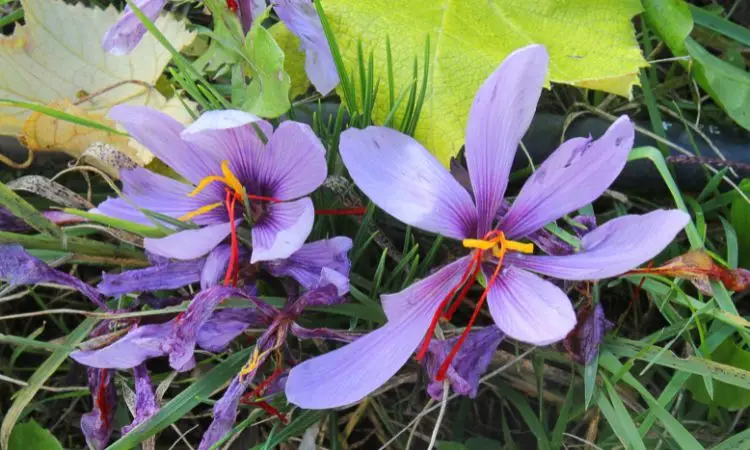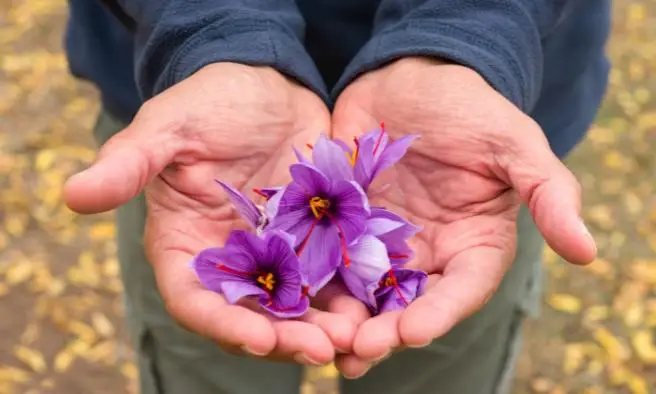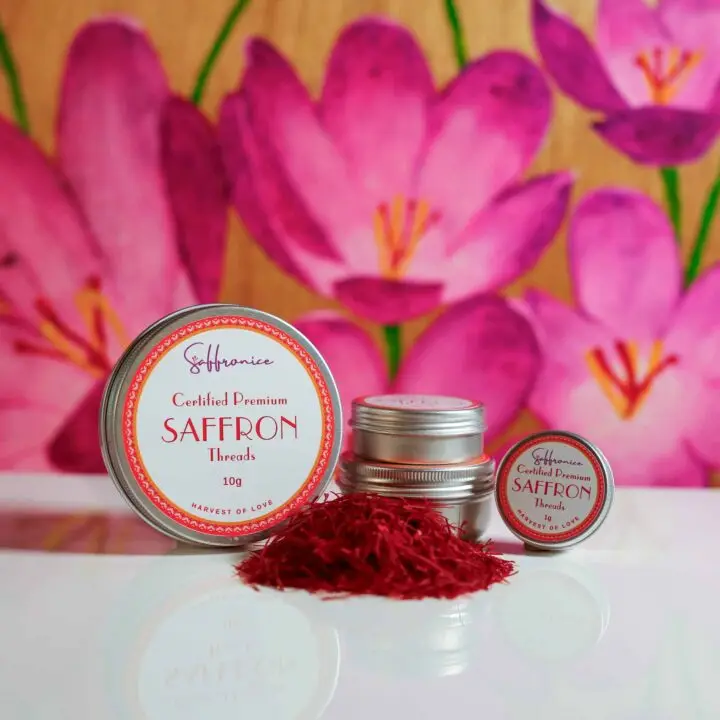📌 Quick Answer: Saffron is the world’s most expensive spice, harvested by hand from the Crocus sativus flower. Each flower yields only three delicate threads, requiring over 14,000 flowers to produce just one ounce. Its rarity, labor-intensive harvesting process, and exceptional flavor profile make it a prized ingredient in cuisines worldwide, commanding prices of $15+ per gram.
Understanding Saffron’s Rarity
Saffron’s got a reputation for being the Gucci of spices, thanks to the backbreaking effort that goes into getting it from field to fork. Pulled from the saffron crocus flower (Crocus sativus), this spice demands a crazy amount of work. To truly understand what saffron is and why it commands such respect, you need to look at the incredible journey from flower to finished product. Each delicate bloom gives just three tiny threads, and getting one ounce of saffron requires plucking more than 14,000 flowers by hand. Yeah, no wonder it’s pricey!
| Quantity | Number of Stigmas Required |
|---|---|
| 1 gram | ~450 |
| 1 ounce | ~15,000 |
Picture workers bent over in fields, collecting those precious threads at dawn to catch them at peak perfection. This level of dedication and elbow grease is what makes saffron so dang exclusive. The history and origins of saffron reveal that this painstaking process has remained virtually unchanged for thousands of years.
But we’re not talking just food. Our ancient OGs knew saffron as a big deal for medicine and turning cloth a brilliant yellow. Its long track record in both healing and art boosts its celebrity status.
Chef’s Professional Tip: When buying saffron, always look for deep red threads with a slight orange tip. These “coupe” grade threads are the highest quality and will give you the most flavor and color for your money.
On the foodie front, saffron’s flavor knows no bounds. It jazzes up everything from Mediterranean paella to Persian rice, Indian sweets, and Italian risottos. Its versatile nature shows why it’s held in such high regard in gourmet circles.
When you factor in its rarity and the careful hands that bring saffron to your table, its historical and modern worth becomes crystal clear.

Saffron Harvesting and Quality
Hard Work in Every Tiny Thread
Saffron, the priciest spice out there, can cost you more than $15 per gram. Why so steep? Because cracking this crocus magic takes back-breaking dedication. Saffron comes from the dried threads of the crocus flower, specifically the flower’s three pollen-loving stigmas. To get just a single ounce, there’s a need to pluck over 14,000 tiny crocus flowers, all by hand.
Here’s what it takes to make this golden spice:
Handpicking: People actually spend their day carefully handpicking each flower, trying not to mess up its fragile threads.
Drying: Once they’re plucked, the stigmas get dried. This step keeps that aroma and flavor alive and kicking.
Sorting and Grading: Finally, the stranded heroes are sorted out and given a quality stamp through established saffron grading systems.
Such tireless effort explains why saffron costs a pretty penny. It’s intense work backed by patience and precision.
The Taste of Location
Where your saffron hails from truly matters, and understanding regional differences helps when you buy saffron online or locally. Best-quality saffron generally lands straight from the Middle East and Asia. Those lucky spots have climate and soil that are perfect for growing top-notch saffron.
| Region | Quality | Characteristics |
|---|---|---|
| Middle East | Top-notch | Rich red, powerful scent, vibrant flavor |
| Asia | Outstanding | Matches the Middle East with a potent punch |
| United States | Underwhelming | Pale shade, less scent, flavor shy |
Food Scientist’s Note: The soil’s mineral content and the specific microclimate where saffron grows directly impact the concentration of crocin (color), safranal (aroma), and picrocrocin (flavor) – the three compounds that determine saffron quality.
These regional quirks are why saffron flavors can flip-flop. Though stateside saffron stands tall, those from the Middle East or Asia usually pack a bigger punch in terms of quality.
Knowing these regional riddles helps you pick saffron with the flavor fireworks you crave, ensuring you squeeze the best flavor out of every precious pinch.
Storage and Handling of Saffron
Best Practices for Maintaining Freshness
Saffron ain’t like yesteryear’s spice. Keeping its aroma and golden glory alive takes a bit of finesse. Proper saffron storage methods are essential to preserve this expensive spice. Here’s how they should keep saffron fresh, like it’s just been gathered from a field:
Cool, Dark Place: Think of saffron like a vampire—it loves the dark. Tuck it away somewhere cool and shady to keep its scent and taste ready to bloom.
Air-tight Container: Lock it up tight, like a treasure trove. This keeps pesky moisture and daylight out. Glass containers with rubber seals work best.
Short-Term Use: Understanding saffron shelf life helps you plan purchases. Use within 6 months for optimal potency, though properly stored saffron can last up to 2 years.
Avoid Refrigeration: Despite popular belief, refrigerators introduce moisture that can damage saffron threads.
Chef’s Professional Tip: Store saffron threads wrapped in foil inside an airtight container. The foil provides an extra barrier against light and moisture, two of saffron’s biggest enemies.
Proper Utilization in Cooking
You know, saffron can make ordinary dishes strut like peacocks. Learning how to cook with saffron properly ensures you get maximum flavor from every thread. Here’s how to tap into its charm in the kitchen:
Steeping: Get those aromatic superpowers firing by soaking a bit of saffron in hot water. You’ll awaken both its fiery color and fragrant flavor. Just 10 threads can turn a pot of rice into something you’d write home about.
Toasting and Grinding: Give those threads a hot spin in a skillet, then crush ’em. Follow it up by steeping. This amps up the taste and scent, turning your dish from zero to hero.
Quality Matters: Don’t skimp on the good stuff. Bargain saffron’s like decaf coffee—it just ain’t the same. Mix top-notch saffron with salt and caramelized onions, and you’ve got saffron rice that’s downright divine.
Timing is Everything: Add steeped saffron toward the end of cooking to preserve its delicate flavor compounds.
For a clearer picture, here’s a nifty table on how to handle saffron like a pro:
| Method | Purpose | Best For |
|---|---|---|
| Steeping | Wake up aromatics and color | Rice dishes, soups, stews |
| Toasting & Grinding | Boosts aroma and taste | Desserts, sauces |
| Quality Selection | Ensures the divine flavor ride | All preparations |
By storing and handling saffron with a touch of care, simple dishes can burst into culinary masterpieces that make even the fussiest foodies swoon.
Culinary Uses of Saffron
Saffron, often dubbed the “golden spice,” brings a distinct taste and a bold splash of color to countless dishes. This spice is a staple in many culinary traditions, used in everything from hearty main courses to delightful desserts.
Saffron in Cultural Recipes
Folks worldwide have been using saffron in their traditional dishes for ages. Its unique flavor makes it a go-to for adding depth to cultural recipes.
Saffron Rice and Tahdig
In Persian kitchens, you’ll find saffron rice dishes and tahdig at the heart of many meals. These dishes get their vibrant yellow hue and aromatic essence from saffron threads. The secret involves toasting saffron, grinding the threads, then steeping them in hot water before mixing with rice – this amps up both taste and aroma. Persian saffron cuisine has perfected these techniques over centuries.
| Dish | Region | Key Ingredients |
|---|---|---|
| Saffron Rice | Middle East | Rice, Saffron, Butter |
| Tahdig | Iran | Rice, Saffron, Yogurt, Oil |
Safran Şerbeti
In Turkey, Safran Şerbeti (that’s Saffron Cordial to you) is a sweet, flowery drink with hints of citrus. Mix in ground saffron threads with sugar, and you’ve got a lively-colored beverage that’s easy on the palate. Not only does it taste great, but many believe it packs some health benefits, too.
Saffron-Infused Desserts
Saffron’s touch of luxury isn’t just for savory dishes. It adds a unique twist to saffron desserts, both traditional and modern, making them flavorful and golden.
Saffron Rice Pudding
Picture this: rice simmered in milk that’s been steeped with saffron threads, creating a rich, creamy pudding. This dessert, topped with bright pomegranate seeds, is as pretty as it is tasty – simple but fancy.
| Dessert | Key Ingredients | Special Features |
|---|---|---|
| Saffron Rice Pudding | Rice, Milk, Saffron, Sugar | Topped with pomegranate seeds |
| Saffron Ice Cream Sandwiches | Ice Cream, Saffron, Cookies | Creamy saffron-infused ice cream between cookies |
| Saffron Jalebi | Flour, Saffron, Sugar Syrup | Deep-fried, syrup-soaked sweet treat |
Saffron Ice Cream Sandwiches
Saffron ice cream sandwiches are a match made in dessert heaven: creamy saffron-flavored ice cream nestled between cookies. The variety of textures and unique saffron flavor turn this treat into a gourmet experience.
Across cultures, saffron doesn’t just pretty up dishes—it elevates their taste profile, enhancing traditional recipes and modern sweets alike with its richness and complexity.
Health Benefits of Saffron
Jumping into the perks of saffron, this ritzy spice ain’t just about sticking out with its taste and flashy color. It’s also got some potential wellness goodies up its sleeve that have been recognized for centuries and are now being validated by modern science.
Potential Health Benefits
Saffron’s got a reputation for bringing all sorts of health boons to the table. The comprehensive saffron health benefits extend far beyond the kitchen. It’s not just about jazzing up your meals—this spice might help lift your spirits, keep inflammation at bay, and pack an antioxidant punch.
| Health Benefit | Description | Supporting Research |
|---|---|---|
| Mood Booster | Saffron helps brighten moods through mood regulation, likely by tweaking serotonin levels in your noggin. | Multiple clinical studies |
| Fights Inflammation | The active compounds in saffron possess anti-inflammatory properties that may help reduce body inflammation. | Laboratory research |
| Antioxidant Power | Chock full of antioxidants like crocin and safranal, saffron takes a swing at nasty free radicals. | Confirmed by nutritional analysis |
| Weight Management | May help control appetite and reduce snacking | Clinical trials |
| Cognitive Support | Shows promise in supporting memory and brain function | Ongoing research |
Food Scientist’s Note: Saffron contains over 150 volatile compounds, but the main bioactive components – crocin, picrocrocin, and safranal – are responsible for most of its therapeutic effects. These compounds have demonstrated antioxidant activity that’s comparable to synthetic antioxidants like BHT.
Incorporating Saffron for Wellness
Bringing saffron into your life is a tasty way to up your wellness game. Here’s how you can get this lovely spice into your daily routines:
Saffron Tea: Toss a few saffron strands in hot water and let them brew for a calming sip. Saffron tea benefits include relaxation and digestive support.
Saffron-Infused Milk: Mix a little saffron with warm milk for a relaxing nightcap that promotes better sleep.
Saffron Supplements: For a more potent saffron kick, grab some capsules. Check the recommended saffron dosage daily amounts to ensure safe and effective use.
Cooking with Saffron: Add it to dishes like risottos, stews, or on rice for flavor and health perks rolled into one.
Chef’s Professional Tip: Start with small amounts if you’re new to saffron. About 30mg (roughly 10-15 threads) per serving is ideal for both flavor and potential health benefits without overwhelming your dish.
Working saffron into your meals isn’t just about the taste—it’s a step towards enjoying its possible health benefits too.
Popular Saffron Recipes
Saffron, the priciest spice around, packs a real punch when it comes to smell and flavor. Here’s how you can bring out its magic in three simple yet mouth-watering dishes.
Creamy Saffron Risotto
This dish is a hug on a plate, and it pairs perfectly with osso buco. The saffron adds that lovely golden hue and an unmistakable taste that feels like you’ve hit the jackpot.
Ingredients:
- 1 cup Arborio rice
- About a pinch of saffron threads
- 1/2 cup dry white wine
- 4 cups chicken or veggie broth
- 1 small onion, chopped up fine
- A stick of butter, but only use a quarter
- A handful of grated Parmesan cheese
- Salt & pepper to make it snazzy
Instructions:
- Warm up the broth like you mean it. Toss in the saffron and let it chill there.
- Get the butter sizzlin’ in another pan and toss in the onion until it’s see-through.
- Add rice and stir it like you’ve got a purpose for about 2 minutes.
- Splash in the wine and wait until it disappears into the rice.
- Here’s the ticket: slowly add broth while stirring so the rice loves you back, absorbing till creamy.
- Toss in Parmesan, get a little salt and pepper action, then serve it steaming.
Monkfish Stew with Saffron Broth
This one’s smooth fishing! Quick to whip up, it’s saffron and white wine goodness that gives it a taste that won’t quit.
Ingredients:
- 1 pound of monkfish in big chunks
- A pinch of saffron threads
- 1 cup of white wine
- 4 cups of fish or veggie broth
- 1 leek, chopped
- 2 carrots, chopped
- 2 potatoes, in cubes
- A couple of tablespoons of olive oil
- Salt & pepper, to taste
- Fresh parsley for fancy points
Instructions:
- Let saffron soak in the wine like it’s at a spa.
- Heat the oil and get the leek, carrot, and potato party started till they’re tender.
- Add your lovely saffron wine and let it boil up.
- Pour in broth and let it be for 10 minutes.
- Throw in monkfish and cook till it’s just done—fishy but not!
- Salt, pepper, and parsley: make it pretty!
Saffron Rice Pudding
This is what you want when you think of ‘comfort dessert.’ Rice gets all cozy with milk and saffron to make something extra special.
Ingredients:
- 1/2 cup Arborio rice
- 4 cups whole milk
- A pinch of saffron threads
- 1/2 cup sugar
- 1 teaspoon vanilla extract
- 2 tablespoons chopped pistachios
- Pomegranate seeds for the fancy topper
Instructions:
- Give the rice a good rinse till the water runs like glass.
- In a saucepan, heat milk and saffron, and bring them to a nice simmer.
- Add rice, cook on low, stir sometimes, about 45 minutes till it’s thick and tender.
- Add sugar, vanilla, and simmer for 5 more minutes.
- Cool a bit and top with pistachios and pomegranates.
Nutritional Information
| Recipe | Calories | Protein (g) | Fat (g) | Carbs (g) |
|---|---|---|---|---|
| Creamy Saffron Risotto | 365 | 10 | 15 | 45 |
| Monkfish Stew with Saffron Broth | 220 | 25 | 6 | 12 |
| Saffron Rice Pudding | 290 | 6 | 7 | 50 |
There ya go! These plates show off saffron in all its glory, reminding you that a little bit goes a long way to fancify your meals.

Saffron in International Cuisines
Saffron, that tiny yet mighty powerhouse of flavor, shines brightly in kitchens around the world. This cherished spice doesn’t just boost the taste and smell of dishes; it also gives them a stunning golden glow, making it a hit with both pro chefs and amateur cooks.
Versatility in Different Cuisines
When it comes to cooking, saffron’s got game. Its magic is sprinkled across a variety of dishes, from the sun-baked shores of the Mediterranean to the bustling streets of India, the rich history of Persia, and the lively markets of the Middle East.
Mediterranean Cuisine: In this neck of the woods, saffron is the star. Imagine a dish like Skillet Chicken and Chorizo Paella; the saffron teams up with rice, chicken, and chorizo to whip up a feast that’s as aromatic as it is tasty.
Indian Cuisine: In India, saffron dances through rice dishes like biryani and sweet treats such as Kesar Peda. It marries effortlessly with spicy and sugary partners, showing off its chameleon-like qualities.
Persian Cuisine: Persian dishes, such as Bastani Irani, a rosewater and saffron ice cream, celebrate saffron’s love affair with floral notes.
Middle Eastern Cuisine: A North African classic like Saffron Chicken Tagine demonstrates saffron’s knack for bringing out the best in meats and veggies with its unmistakable flair.
Saffron’s Role in Regional Dishes
In some recipes, saffron isn’t just an ingredient—it’s the heartbeat. Here’s where saffron takes the lead role, adding character and depth to these cherished dishes.
Iran: Safran Şerbeti is an Iranian refresher that highlights how saffron is steeped in the country’s culinary roots.
Mexico: How about adding a twist to a classic with a Mexican Shrimp Cocktail laced with saffron? It weaves in saffron’s gentle sweetness to elevate this seafood starter.
Turkey: In Turkey, saffron graces dishes like pilaf, tinting the rice with its warm color and indulgent taste.
| Dish | Region | Key Ingredients |
|---|---|---|
| Skillet Chicken and Chorizo Paella | Spain | Saffron, Rice, Chicken, Chorizo |
| Saffron Chicken Tagine | North Africa | Saffron, Chicken, Vegetables |
| Bastani Irani | Iran | Saffron, Rosewater, Milk |
| Safran Şerbeti | Turkey | Saffron, Water, Sugar |
Thanks to its global charm and adaptability, saffron holds its place as the top dog in gourmet spices. It’s the secret weapon that makes traditional dishes pop and adds a sprinkle of magic to modern cuisine, keeping food lovers everywhere on their toes and coming back for more.
Tips for Cooking with Saffron
Boosting Flavor and Aroma
Getting the most out of saffron takes a few clever tricks to bring out its flavor and smell. Here’s how you can do it:
Toast & Crush: Gently warming saffron threads in a dry pan can crank up their aroma. After that, crush them into a fine powder. This makes the flavor and color really pop by giving them more surface area to mingle with your dish.
Soak It: Mix up your crushed saffron with hot water or broth and let it hang out for a good 10-15 mins. This process draws out that deep golden color and those full-bodied flavors.
Temperature Matters: Never add saffron to boiling liquids – use warm (not hot) water around 150°F to preserve delicate flavor compounds.
For many dishes, about 30-50 mg of saffron threads is all you need to add both a pop of flavor and a rich golden tint.
Saffron Pairings in Recipes
Saffron’s one-of-a-kind taste goes hand-in-hand with all sorts of goodies. Check out these winning combos:
| Ingredient | Dish Examples |
|---|---|
| Seafood | Seafood pasta, Fish stew, Shrimp with saffron, Calamari with saffron aioli |
| Rice | Saffron rice pudding, Paella, Biryani |
| Dairy | Saffron-infused milk, Creamy saffron sauces, Cheese dishes |
| Meats | Lamb stew, Chicken tagine, Beef with saffron sauce |
| Vegetables | Saffron veggie soup, Roasted veggies with saffron dressing |
Saffron doesn’t just make everything taste better—it also adds a dash of elegance and a rich feel to your dishes.
Using saffron the right way amps up your meals, delivering both taste and a feast for the eyes. Try out these tricks to really make this precious spice shine in your cooking adventures.
Frequently Asked Questions About Saffron
How much saffron should I use in cooking?
For most recipes, 10-15 threads (about 30mg) of saffron is sufficient for 4-6 servings. Remember, a little goes a long way. Always steep the threads in warm liquid before adding to your dish to extract maximum flavor and color.
Can I substitute turmeric for saffron?
While turmeric can provide a similar golden color, it cannot replicate saffron’s unique flavor profile. Turmeric has an earthy, slightly bitter taste, while saffron offers a delicate, floral sweetness. They’re not interchangeable in terms of taste, though turmeric works as a budget-friendly coloring alternative.
How can I tell if my saffron is real?
Genuine saffron threads are deep red with slightly lighter orange tips. Drop a few threads in warm water – real saffron releases color slowly over 10-15 minutes and retains its red color. Fake saffron dyes the water immediately, and the threads turn white or pale.
Does saffron expire?
When stored properly in an airtight container away from light and moisture, saffron can maintain its potency for 6 months to 2 years. However, it’s best used within 6 months for optimal flavor and aroma.
Is saffron safe to consume daily?
Yes, saffron is generally safe when consumed in culinary amounts (30-50mg per day). However, doses exceeding 5 grams can be toxic. Pregnant women should consult their doctor before using saffron supplements, though culinary amounts in food are typically safe.
🔑 Key Takeaways
- Saffron is rare and valuable – It takes over 14,000 hand-picked flowers to produce just one ounce, making it the world’s most expensive spice.
- Quality varies by origin – Middle Eastern and Asian saffron typically offers superior color, aroma, and flavor compared to other regions.
- Proper storage is crucial – Keep saffron in an airtight container in a cool, dark place to maintain its potency for up to 6 months.
- Preparation enhances flavor – Toasting and steeping saffron threads before use maximizes both color and taste in your dishes.
- Health benefits are real – Beyond culinary uses, saffron offers potential mood-boosting, anti-inflammatory, and antioxidant properties that can support overall wellness.



